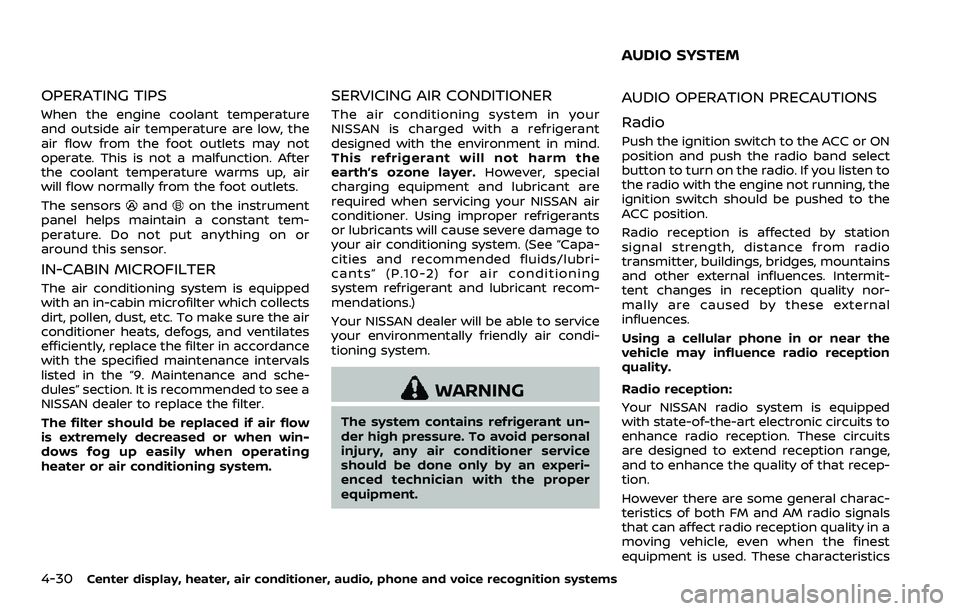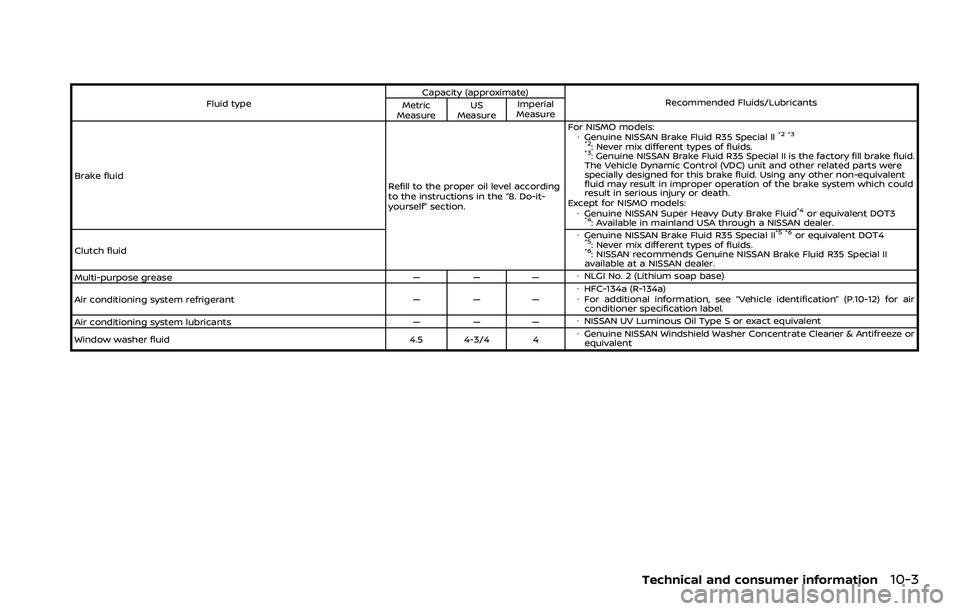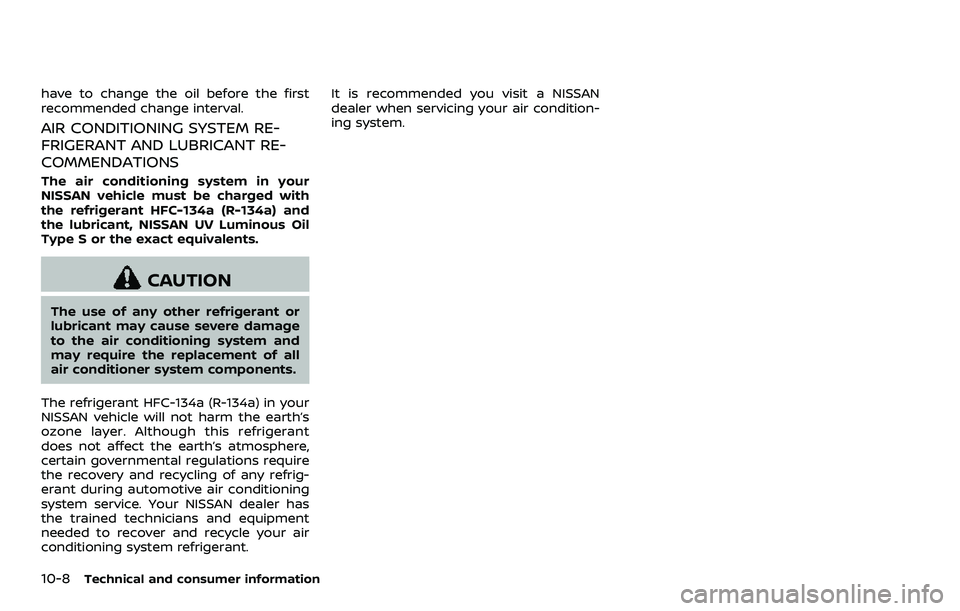2018 NISSAN 370Z COUPE air conditioning
[x] Cancel search: air conditioningPage 198 of 453

4-30Center display, heater, air conditioner, audio, phone and voice recognition systems
OPERATING TIPS
When the engine coolant temperature
and outside air temperature are low, the
air flow from the foot outlets may not
operate. This is not a malfunction. After
the coolant temperature warms up, air
will flow normally from the foot outlets.
The sensors
andon the instrument
panel helps maintain a constant tem-
perature. Do not put anything on or
around this sensor.
IN-CABIN MICROFILTER
The air conditioning system is equipped
with an in-cabin microfilter which collects
dirt, pollen, dust, etc. To make sure the air
conditioner heats, defogs, and ventilates
efficiently, replace the filter in accordance
with the specified maintenance intervals
listed in the “9. Maintenance and sche-
dules” section. It is recommended to see a
NISSAN dealer to replace the filter.
The filter should be replaced if air flow
is extremely decreased or when win-
dows fog up easily when operating
heater or air conditioning system.
SERVICING AIR CONDITIONER
The air conditioning system in your
NISSAN is charged with a refrigerant
designed with the environment in mind.
This refrigerant will not harm the
earth’s ozone layer. However, special
charging equipment and lubricant are
required when servicing your NISSAN air
conditioner. Using improper refrigerants
or lubricants will cause severe damage to
your air conditioning system. (See “Capa-
cities and recommended fluids/lubri-
cants” (P.10-2) for air conditioning
system refrigerant and lubricant recom-
mendations.)
Your NISSAN dealer will be able to service
your environmentally friendly air condi-
tioning system.
WARNING
The system contains refrigerant un-
der high pressure. To avoid personal
injury, any air conditioner service
should be done only by an experi-
enced technician with the proper
equipment.
AUDIO OPERATION PRECAUTIONS
Radio
Push the ignition switch to the ACC or ON
position and push the radio band select
button to turn on the radio. If you listen to
the radio with the engine not running, the
ignition switch should be pushed to the
ACC position.
Radio reception is affected by station
signal strength, distance from radio
transmitter, buildings, bridges, mountains
and other external influences. Intermit-
tent changes in reception quality nor-
mally are caused by these external
influences.
Using a cellular phone in or near the
vehicle may influence radio reception
quality.
Radio reception:
Your NISSAN radio system is equipped
with state-of-the-art electronic circuits to
enhance radio reception. These circuits
are designed to extend reception range,
and to enhance the quality of that recep-
tion.
However there are some general charac-
teristics of both FM and AM radio signals
that can affect radio reception quality in a
moving vehicle, even when the finest
equipment is used. These characteristics
AUDIO SYSTEM
Page 316 of 453

5-24Starting and driving
To reset at a slower cruising speed,use
one of the following methods:
. Lightly tap the brake pedal. When the
vehicle attains the desired speed,
push the COAST/SET switch and re-
lease it.
. Push and hold the COAST/SET switch.
Release the switch when the vehicle
slows down to the desired speed.
. Push, then quickly release the COAST/
SETT switch. Each time you do this,
the set speed will decrease by about 1
MPH (1.6 km/h).
To resume the preset speed, push and
release the ACCEL/RES switch. The vehi-
cle will resume the last set cruising speed
when the vehicle speed is over 25 MPH
(40 km/h).
CAUTION
During the first 1,200 miles (2,000
km), follow these recommendations
to obtain maximum engine perfor-
mance and ensure the future relia-
bility and economy of your new
vehicle.
Failure to follow these recommenda-
tions may result in shortened engine
life and reduced engine perfor-
mance.
. Avoid driving for long periods at con-
stant speed, either fast or slow. Do not
run the engine over 4,000 rpm.
. Do not accelerate at full throttle in any
gear.
. Avoid quick starts.
. Avoid hard braking as much as possi-
ble. Follow these easy-to-use Fuel Efficient
Driving Tips to help you achieve the most
fuel economy from your vehicle.
1. Use smooth accelerator and brake
pedal application.
.Avoid rapid starts and stops..Use smooth, gentle accelerator andbrake application whenever possi-
ble.
.Maintain constant speed whilecommuting and coast whenever
possible.
2. Maintain constant speed.
.Look ahead to try and anticipate and minimize stops.
.Synchronizing your speed with traf-fic lights allows you to reduce your
number of stops.
.Maintaining a steady speed canminimize red light stops and im-
prove fuel efficiency.
3. Use air conditioning (A/C) at higher vehicle speeds.
.Below 40 MPH (64 km/h), it is moreefficient to open windows to cool
the vehicle due to reduced engine
load.
.Above 40 MPH (64 km/h), it is more
efficient to use A/C to cool the
vehicle due to increased aerody-
namic drag.
BREAK-IN SCHEDULE FUEL EFFICIENT DRIVING TIPS
Page 419 of 453

10 Technical and consumer information
Capacities and
recommended fluids/lubricants ...................................... 10-2Fuel information .................................................................... 10-4
Engine oil and oil filter recommendation .......... 10-7
Air conditioning system refrigerant and
lubricant recommendations ....................................... 10-8
Specifications ........................................................................\
.......... 10-9 Engine ........................................................................\
.................... 10-9
Wheels and tires ................................................................. 10-10
Dimensions ........................................................................\
....... 10-11
When traveling or registering in
another country ........................................................................\
. 10-12
Vehicle identification .............................................................. 10-12 Vehicle Identification Number (VIN) plate ....... 10-12
Vehicle identification number
(chassis number) ................................................................. 10-12
Engine serial number ....................................................... 10-13
F.M.V.S.S./C.M.V.S.S. certification label ................. 10-13
Emission control information label ...................... 10-13
Tire and Loading Information label ..................... 10-14
Air conditioner specification label ......................... 10-14
Installing front license plate ............................................. 10-15 Except for NISMO models ............................................ 10-15
For NISMO models ............................................................. 10-17 Removing air deflectors (except for
NISMO models) ........................................................................\
.... 10-18
Vehicle loading information ............................................. 10-19
Terms ........................................................................\
................. 10-19
Vehicle load capacity .................................................. 10-20
Loading tips ........................................................................\
.. 10-21
Measurement of weights ........................................... 10-21
Towing a trailer ........................................................................\
. 10-22
Flat towing ........................................................................\
............ 10-22 Automatic transmission ............................................. 10-22
Manual transmission .................................................... 10-22
Uniform tire quality grading ........................................... 10-23 Treadwear ........................................................................\
..... 10-23
Traction AA, A, B and C .............................................. 10-23
Temperature A, B and C ............................................ 10-23
Emission control system warranty ............................ 10-24
Reporting safety defects ................................................... 10-24
Readiness for Inspection/Maintenance
(I/M) test ........................................................................\
.................. 10-25
Event Data Recorders (EDR) ............................................ 10-25
Owner’s Manual/Service Manual
order information .................................................................... 10-26
Page 421 of 453

Fluid typeCapacity (approximate)
Recommended Fluids/Lubricants
Metric
Measure US
Measure Imperial
Measure
Brake fluid Refill to the proper oil level according
to the instructions in the “8. Do-it-
yourself” section.For NISMO models:
�ÂGenuine NISSAN Brake Fluid R35 Special ll
*2 *3
*2: Never mix different types of fluids.*3: Genuine NISSAN Brake Fluid R35 Special II is the factory fill brake fluid.
The Vehicle Dynamic Control (VDC) unit and other related parts were
specially designed for this brake fluid. Using any other non-equivalent
fluid may result in improper operation of the brake system which could
result in serious injury or death.
Except for NISMO models:
�ÂGenuine NISSAN Super Heavy Duty Brake Fluid
*4or equivalent DOT3*4: Available in mainland USA through a NISSAN dealer.
Clutch fluid �Â
Genuine NISSAN Brake Fluid R35 Special II*5 *6or equivalent DOT4*5: Never mix different types of fluids.*6: NISSAN recommends Genuine NISSAN Brake Fluid R35 Special II
available at a NISSAN dealer.
Multi-purpose grease — — — �Â
NLGI No. 2 (Lithium soap base)
Air conditioning system refrigerant — — — �Â
HFC-134a (R-134a)
� For additional information, see “Vehicle identification” (P.10-12) for air
conditioner specification label.
Air conditioning system lubricants — — — �Â
NISSAN UV Luminous Oil Type S or exact equivalent
Window washer fluid 4.5 4-3/4 4 �Â
Genuine NISSAN Windshield Washer Concentrate Cleaner & Antifreeze or
equivalent
Technical and consumer information10-3
Page 426 of 453

10-8Technical and consumer information
have to change the oil before the first
recommended change interval.
AIR CONDITIONING SYSTEM RE-
FRIGERANT AND LUBRICANT RE-
COMMENDATIONS
The air conditioning system in your
NISSAN vehicle must be charged with
the refrigerant HFC-134a (R-134a) and
the lubricant, NISSAN UV Luminous Oil
Type S or the exact equivalents.
CAUTION
The use of any other refrigerant or
lubricant may cause severe damage
to the air conditioning system and
may require the replacement of all
air conditioner system components.
The refrigerant HFC-134a (R-134a) in your
NISSAN vehicle will not harm the earth’s
ozone layer. Although this refrigerant
does not affect the earth’s atmosphere,
certain governmental regulations require
the recovery and recycling of any refrig-
erant during automotive air conditioning
system service. Your NISSAN dealer has
the trained technicians and equipment
needed to recover and recycle your air
conditioning system refrigerant. It is recommended you visit a NISSAN
dealer when servicing your air condition-
ing system.
Page 445 of 453

11 Index
A
ABS (Anti-lock Braking System) ......................... 5-28
Active noise cancellation......................................... 5-35
Active sound enhancement.................................. 5-35
Advanced air bag system ........................................ 1-36
Air bag systemAdvanced air bag system ................................ 1-36
Front passenger air bag and
status light................................................................... 1-38
Front-seat mounted side-impact
supplemental air bag system........................ 1-41
Roof-mounted curtain side-impact
supplemental air bag system........................ 1-41
Air bag warning labels ............................................... 1-44
Air bag warning light...................................... 1-44, 2-14
Air cleaner housing filter .......................................... 8-15
Air conditioner Air conditioner operation................................ 4-25
Air conditioner service....................................... 4-30
Air conditioner specification label........... 10-14
Air conditioning system refrigerant and
lubricant recommendations ............ 4-30, 10-8
In-cabin microfilter ............................................... 4-30
Air deflectors ................................................................... 10-18
Alarm, How to stop alarm (see vehicle
security system)............................................................. 2-30
Alcohol, drugs and driving ........................................ 5-7
Antenna........................................................................\
......... 4-74
Anti-lock Braking System (ABS) ......................... 5-28
Anti-lock braking system (ABS)
warning light ....................................................................... 2-11
Appearance care Exterior appearance care .................................. 7-2
Interior appearance care.................................... 7-5
Audible reminders.......................................................... 2-18 Audio operation precautions .............................. 4-30
Audio system ................................................................... 4-30
FM-AM radio with Compact Disc
(CD) player ................................................................... 4-43
FM-AM-SAT radio with Compact Disc
(CD) player ................................................................... 4-52
Steering wheel audio controls.................... 4-73
Autolight system............................................................ 2-35
Automatic Air conditioner (Type A).................................... 4-26
Air conditioner (Type B).................................... 4-28
Automatic adjusting function
(front windows) ....................................................... 2-49
Automatic Transmission Fluid (ATF) ......... 8-8
Door locks....................................................................... 3-6
Driving with automatic transmission..... 5-12
Auxiliary input jacks.................................................... 4-70
Avoiding collision and rollover............................... 5-6
B
Battery........................................................................\
.............. 8-11 Battery saver system.......................................... 2-36
Intelligent Key........................................................... 8-20
Variable voltage control system ................ 8-13
Before starting the engine....................................... 5-11
Belts (See drive belts).................................................. 8-14
Bluetooth® hands-free phone system
(models with navigation system) ..................... 4-76
Bluetooth® hands-free phone system
(models without navigation system) ............ 4-86
Bluetooth® streaming audio................................. 4-63
Booster seats...................................................................\
.. 1-26
Brake Anti-lock Braking System (ABS) ................. 5-28
Brake and clutch fluid .......................................... 8-9 Brake fluid ...................................................................... 8-9
Brake system ............................................................ 5-27
Parking brake operation................................... 5-21
Warning light............................................................... 2-11
Break-in schedule ......................................................... 5-24
Brightness control .......................................................... 4-8 Display ON/OFF button ....................................... 4-8
Instrument panel ................................................... 2-37
Bulb replacement .......................................................... 8-22
C
Cabin air filter .................................................................. 4-30
Capacities and
recommended fluids/lubricants........................ 10-2
Car phone or CB radio .............................................. 4-75
Cargo cover ....................................................................... 2-45
Catalytic converter, Three way catalyst ........ 5-3
CD/DVD/USB memory care
and cleaning...................................................................... 4-72
Center multi-function control panel
(models with navigation system) ....................... 4-4
Chassis and body maintenance.......................... 9-11
Child restraints .................................................................. 1-19 Booster seats............................................................. 1-26
Precautions on child restraints.................... 1-19
Top tether strap ...................................................... 1-20
Child safety........................................................................\
... 1-16
Chimes Audible reminders.................................................. 2-18
Seat belt warning light and chime........... 2-14
Circuit breaker, Fusible link ................................... 8-18
Cleaning exterior and interior ...................... 7-2, 7-5
Clock ........................................................................\
...... 2-9, 2-27
Clutch fluid........................................................................\
.... 8-9
Cockpit ........................................................................\
.............. 2-3